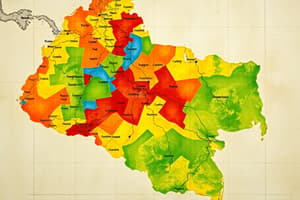Podcast
Questions and Answers
Evaluate how the Hukou system in China exacerbates socio-economic disparities between rural migrants and urban residents, considering its impact on access to social benefits and long-term urban integration.
Evaluate how the Hukou system in China exacerbates socio-economic disparities between rural migrants and urban residents, considering its impact on access to social benefits and long-term urban integration.
The Hukou system restricts access to social benefits for rural migrants in urban areas, creating a two-tiered system where they often lack access to education, healthcare, and housing. This limited access hinders their ability to fully integrate and improve their socio-economic status, perpetuating inequality.
Critically analyze the potential long-term demographic and economic consequences of China's rapid industrialization and urbanization on its rural regions, considering factors such as labor force depletion and investment deficits.
Critically analyze the potential long-term demographic and economic consequences of China's rapid industrialization and urbanization on its rural regions, considering factors such as labor force depletion and investment deficits.
Rapid industrialization and urbanization lead to labor force depletion in rural areas, as young people migrate to cities for better opportunities. This can result in decreased agricultural productivity, rural depopulation, and a lack of investment, hindering the long-term economic development of rural regions.
Assess the multifaceted challenges and opportunities presented by megacity growth in China, with a particular focus on balancing economic development with social equity and environmental sustainability.
Assess the multifaceted challenges and opportunities presented by megacity growth in China, with a particular focus on balancing economic development with social equity and environmental sustainability.
Megacity growth in China presents opportunities such as economic development and innovation but also poses challenges like overcrowding, pollution, and social inequality. Balancing these requires sustainable urban planning, equitable resource distribution, and policies that address environmental impact.
Compare and contrast the factors influencing fertility rates and life expectancy in the UK and Afghanistan, and evaluate the broader implications of these demographic indicators on their respective socio-economic development trajectories.
Compare and contrast the factors influencing fertility rates and life expectancy in the UK and Afghanistan, and evaluate the broader implications of these demographic indicators on their respective socio-economic development trajectories.
Analyze how geographical factors, such as harsh climates and mountainous terrain, can intersect with economic policies to shape regional disparities in China's development, using specific examples like Tibet and the eastern coastal cities.
Analyze how geographical factors, such as harsh climates and mountainous terrain, can intersect with economic policies to shape regional disparities in China's development, using specific examples like Tibet and the eastern coastal cities.
Explain how a country's infrastructure development can influence its population distribution, providing a specific example.
Explain how a country's infrastructure development can influence its population distribution, providing a specific example.
How might political instability in a region alter established patterns of population distribution? Provide a concise explanation.
How might political instability in a region alter established patterns of population distribution? Provide a concise explanation.
Describe the relationship between GNI per capita, birth rates and quality of life in high income economies.
Describe the relationship between GNI per capita, birth rates and quality of life in high income economies.
Evaluate the impact of natural resources on population density, using the Middle East as an example.
Evaluate the impact of natural resources on population density, using the Middle East as an example.
Compare and contrast the population distribution challenges faced by low-income economies versus high-income economies.
Compare and contrast the population distribution challenges faced by low-income economies versus high-income economies.
Explain how the core-periphery model applies to population distribution and economic development within a country, such as the UK.
Explain how the core-periphery model applies to population distribution and economic development within a country, such as the UK.
Assess the long-term implications of megacity growth for urban planning and resource management, citing an example such as London.
Assess the long-term implications of megacity growth for urban planning and resource management, citing an example such as London.
Critically evaluate urban to rural migration. What are the main drivers and potential socio-economic impacts?
Critically evaluate urban to rural migration. What are the main drivers and potential socio-economic impacts?
Flashcards
Industrialisation
Industrialisation
Rapid development of industry, leading to city growth.
Urbanisation
Urbanisation
The shift of people from rural areas to cities.
Hukou System
Hukou System
System restricting movement by tying benefits to region of origin.
Natural Increase
Natural Increase
Signup and view all the flashcards
Fertility Rate
Fertility Rate
Signup and view all the flashcards
Coastal Population Distribution
Coastal Population Distribution
Signup and view all the flashcards
Temperate Climate & Population
Temperate Climate & Population
Signup and view all the flashcards
Topography & Population Density
Topography & Population Density
Signup and view all the flashcards
Natural Resources & Population
Natural Resources & Population
Signup and view all the flashcards
Employment & Job Opportunities
Employment & Job Opportunities
Signup and view all the flashcards
Infrastructure & Population
Infrastructure & Population
Signup and view all the flashcards
Political Stability & Population
Political Stability & Population
Signup and view all the flashcards
Core regions
Core regions
Signup and view all the flashcards
Study Notes
- Physical and human factors influence global population distribution.
Physical Factors
- Water supply affects population distribution, with over 75% residing within 100 km of a coast.
- Temperate climates are preferred; 85% of the global population lives between 20-68 degrees North.
- Flat, fertile land attracts populations; 85% live below 500m elevation.
- Natural resources (e.g., oil in the Middle East) influence population density.
Human Factors
- Urban, industrialized areas with job opportunities and higher wages attract people.
- Well-developed infrastructure (healthcare, education, transport) increases quality of life.
- Political stability is crucial; war leads to population decline as people flee.
- Efficient communications (road, sea, air) enable population concentration.
Global Patterns of Economic Development
- Low-income economies have a GNI per capita less than $1146 (e.g., Sudan).
- Low-income economies usually have high birth rates, low life expectancy, and high dependency ratios.
- Middle-income/emerging economies have a GNI per capita between $1,146-$14,000 (e.g., China).
- Industrialization in middle-income economies leads to rapid urbanization.
- High-income economies have a GNI per capita exceeding $14,000.
- High-income economies often have aging populations, high living standards, and low birth rates.
Population Distribution and Economic Development: UK
- The UK is densely populated in the south, including London and Manchester, due to jobs, education, and infrastructure.
- London & Manchester also benefit from a mild climate and flat land.
- Sparsely populated in the north (Scotland, Wales) due to fewer jobs and less developed transport.
- Mountainous landscapes, colder temperatures, and poor soil contribute to sparse northern populations.
- The UK is a high-income economy with London as its economic hub.
Core-Periphery Model in the UK
- The core is the central economic region with good technology, communications, employment, and education.
- The periphery is an outlying region characterized by poor communications, sparse population, and unemployment.
- Peripheral regions also have a workforce in the primary sector, poor housing, and less technology.
- South East England, including London and Manchester, serves as the UK's core regions, with global influence.
- Urban to rural migration happens as retirees and families seek a calmer lifestyle.
- London has a population of 9.7 million, with growth due to immigration for work.
Population Distribution and Economic Development: China
- China is densely populated in the east (e.g., Shanghai) because of jobs, trade, infrastructure, fertile land, and a mild climate.
- Sparsely populated in the west due to a lack of jobs, harsh climates, and mountainous terrain (e.g., Tibet).
- China is an emerging economy undergoing rapid industrialization and urbanization.
- The east of China is more economically developed than the west.
Core-Periphery Model in China
- Eastern coastal cities like Shanghai and Shenzhen are economic cores.
- Western China (e.g., Tibet, Xinjiang) remains relatively undeveloped.
- The Hukou system restricts internal migration by tying social benefits to the region of origin.
- Many people migrate from rural to urban areas but lack residency status due to Hukou, leading to risky living conditions.
- China has 19 megacities, driven by industrialization, urbanization, and migration.
Population Change and Demographic Transition
- Natural increase is the surplus of births over deaths in a population.
- The UK has a low natural increase (less than 1%), driven by a declining birth rate and increased life expectancy.
- Afghanistan has a high natural increase (2.2%), with a high birth rate and a declining but still relatively high death rate.
- Fertility rate represents the average number of children a woman gives birth to.
- The UK has a fertility rate of 1.7 children per woman, leading to slow population growth due to career aspirations and later marriage.
- Afghanistan's fertility rate is 4.6 children per woman because of limited access to contraception and high infant mortality.
- UK life expectancy is 81 years because of universal healthcare (NHS) and a high quality of life.
- Afghanistan's life expectancy is 65 years because of poor healthcare and high infant mortality.
Internal Migration: India
- Internal migration is significant, driven by population pressure and limited opportunities in rural areas.
- Mumbai's population growth results from migration, with approximately 27 million people.
- Mumbai's population growth strains resources and exacerbates inequalities.
- Extreme wealth disparities exist between luxury areas like Malabar Hill and slums where millions reside.
- Economic growth can move people and boost the economy.
Consequences in Rural Areas in India
- Lack of available workers due to migration
- Resultant rural depopulation
- Families are split up, with older people and children left behind.
- Lacking investment
Studying That Suits You
Use AI to generate personalized quizzes and flashcards to suit your learning preferences.
Description
Explore physical, human, and economic factors influencing population distribution. Learn how climate, resources, infrastructure, and economic development shape where people live. Discover global patterns related to these factors.




